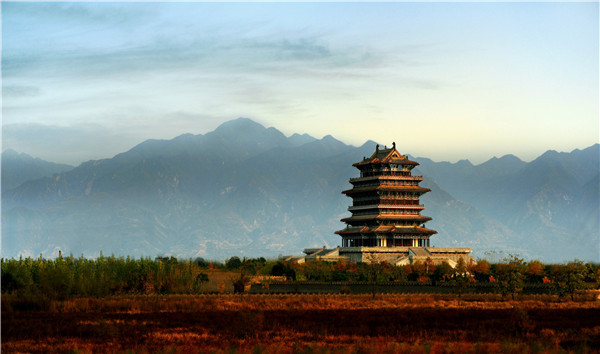
The Stork Tower is also known as the Stork Tower because the storks sometimes live on top of it, and it is on the western outskirts of the ancient town Puzhou, Yongji city, Shanxi Province, which is located at the junction of Jin, Qin and Yu provinces on the banks of the Yellow River. Wang Zhihuan, a poet in the Tang Dynasty, wrote a poem" On the Stork Tower ". The sun along the mountain bows; The Yellow river seawards flows. If you'll enjoy a grander sight, you’d climb up to a greater height”, which makes it famous all over the world and it has been the landmark of the Yellow River Basin.
Founded in the Northern Zhou Dynasty, around 557-581 A.D., the Stork Tower was built by General Yu Wen of the North Zhou Dynasty and it has been used as a military building by the Tang Dynasty and Song Dynasty. It lasted more than 700 years and was destroyed in the early years of the Yuan Dynasty until it was first rebuilt in 1997 and in September 2002. It is officially open to visitors.
The newly rebuilt building is decorated with the paintings of the Tang Dynasty. It is a four-eaves three-story imitation of Tang-style building with a height of 73.9 meters. It sits in the south and faces in the north, in the west of the Yellow River in the south of the mountains, overlooking the archaeological site of the Shun City, near the water of the Yellow River from the sky. The entire scenic area covers an area of 2.064 square kilometers. As the center, the Stork Tower surrounded by classical gardens, with four areas 12 points layout structure. (1) The famous building sightseeing area. It Includes the Gate Hall, the Stork Shadow Lake, Tang Yun Square and the Center of the Famous Building Browsing Area. To be built: (1) Yellow River style sightseeing area which includes Puzhou style garden, Yellow River style museum and Liuyuan Garden. (2) Landscape browsing area which includes Cangshan Forest Natural Landscape Area, Auspicious Lake and The Peacock Garden. (3) Recreational browsing area includes Pujin Kangle Garden, Tang Dynasty horse polo stadium and Ritan Water Park.
The whole scenic area is based on the unique human heritage and profound Yellow River culture, covered the social spirit and culture in the Glorious age of Tang Dynasty, with the characteristics of regional history and culture, with the theme of great patriotism. “If you'll enjoy a grander sight, you’d climb up to a greater height " is the key momentum for the main melody, formed the conception of " from the ups and downs of five thousand years to look forward to the world" make it become a world-wide tourist attractions for sightseeing, leisure, vacation.
The key landscape locations in the scenic area are planned carefully. According to the geographical location, historical background, cultural connotation and garden rules to achieve the perfect combination. The building embodies the symbolism, simple and elegance and the natural coordination, etc. Such magnificent tower renders the spirit of the Chinese culture, thus giving people a vast, majestic and high appeal. So that visitors walking in the ancient pride, can dissolve into the feeling of the landscape. Each key landscape layout makes full use of the natural ecological environment along the Yellow River, so that the orderly whole scenic area forms a prelude-music-high tide-endless human landscape. The harmonious symphonies, such as natural landscape and garden architecture, reflect the lofty and far-reaching mood of "Chinese famous building, unique in the Yellow River".
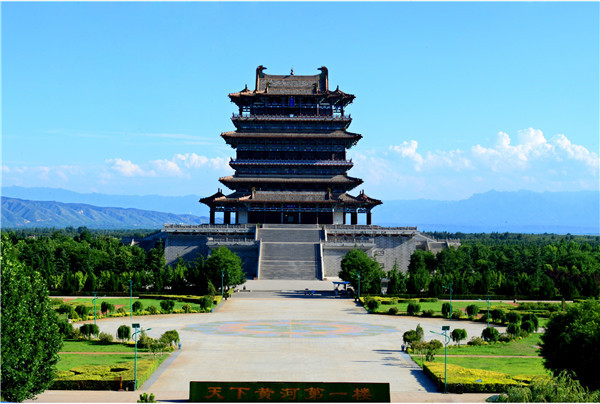
【The Hall of the Stork Garden】
The Hall of Stork Garden is the first building in the entrance area. It sits in the south and faces in the north. It is a distinctive simulation of the Tang Temple, which is simple in shape, robust and unusual. All around are cloisters and arch beams are all colorless paintings, only the red. The plaque of Stork Garden with three golden big words hangs on the top written by Mr. Qigong, a famous contemporary calligrapher. His handwriting building added a few cultural connotations to the scenic area. Each garden has its door with the architectural style of the Tang Dynasty. The scenic front wall connects the semi-circular layout, which means a warm welcome to the visitors all over the world.
【The Guanying Lake】
Through the gate hall, green grass carpets the ground on both sides and fountains splashed beautifully. The square is open and flat as if it were a welcome square. Wang Zhihuan, a poet in the Tang Dynasty, wrote the poem “On the Stork Tower” so the poem attracts thousands of people to come to Puzhou, to visit the Stork Tower. Many scholars and poets wrote a lot of poems about the Stork Tower, but none of Wang’s poems have a long-term and extensive impact. “The sun along the mountain bows; the Yellow river seawards flows. If you'll enjoy a grander sight, you’d climb up to a greater height.” It is the pinnacle of the Tang poetry, and it has thus become a symbol of the height of the Tang poetry. After the completion of the Stork Tower, it goes through the Tang Dynasty and Song Dynasty, standing there straight more than 700 years, till the years of Mingchang, the building still as strong as before. In the early years of the Yuan Dynasty, the Jin’s soldiers and the Yuan’s soldiers competed for Puzhou, and the Stork Tower was also burned to the fire. For more than 800 years, there was a legend and a site left here. After the reform and opening up, in order to inherit the traditional culture of the motherland and develop the tourism industry, Yongji people in this vast beach rebuilt this thousand-year-old famous building.
The Guanying Lake is a small lake carved by hand, the shapes in the east and in the west is similar to the wings of the birds. It is the image of the bird stork for the cultural meaning, because we named after it for thousands of years.
The stork is a kind of water bird, like a heron and a crane. Some are black and some are white. They have sharp beaks and slender legs. They often shoal in the water motionlessly, while those small fish and shrimps are not aware of the danger thus they become their delicious meal. Local residents call the birds "always waits". At night, they often perch in groups upstairs.
【Shengtang Square】
Shengtang Square is the further presentation and display of the culture of the Glorious age of Tang Dynasty. It is not only the continuity of the Tang Dynasty style of the door hall, Welcome Guest square and the Shadow Lake, but also the Tang Dynasty poetry building. Visitors can feel the creation of Tang culture when they enter this scenic spot from the front door and get the strong affection of Tang culture as well. Shengtang Square with an axis symmetry and board-style layout, geometric garden shape, different colors of plants composed of lawns, a variety of valuable trees three-dimensional embellishment, empty space all with colored tiles stitched together for the Tang Dynasty widely used traditional patterns, lotus shape, which is as desired, all these pleases the eyes attractively. The square is open and horizontal with the amazing field of view, the layout is simple with the beautiful shape, the cultural connotation and the natural scenery is harmonious and unified. Without going upstairs, we have felt the charm and the inspiration of the Glorious age of Tang Dynasty. After the building was built, we found a magical echo effect in front of the building. Now you can stand in the middle of the square and listen, and we can hear a bird's song. What's that sound? In fact, this kind of voice is what we call the chirp of the stork, the song of the stork on our square mains the building mysterious. The constant change of voice sounds like the chirp from a little stork to an old one. This sound can be heard on all sides of our main building. This is not the intention of building but the formation of nature. It is said to be the creation and gift of the nature.
【The Platform】
Under the Stork Tower is the tall building with the striking Chinese character the Stork Tower written by the General Secretary Jiang Zemin. In March 1993, Comrade Jiang Zemin wrote the poem “On the Stork Tower", which gave great encouragement to the re-construction of the Stork Tower. In January 1994, he came to Shanxi to inspect the work, especially the Puzhou Cultural Scenic Area. He took notice of the reconstruction and location of the building. In August 2001, Comrade Jiang Zemin came to Shanxi again at the request of the Shanxi Provincial Committee and the provincial government, he happily wrote the name of the building for the under-construction of the Stork Tower. Now this plaque is solemn and large, the momentum is magnificent, reflecting the highest level of the country's cultural taste.
【The Main Building】
The main building of the Stork Tower is located on a tall platform. Standing on the platform, we will feel its grand solemnity. The platform is rectangular, 83 meters long, 72 meters wide from the north to south, and 310 meters in circumference. The main building is 57.4 meters high and the total height of the entire building is 73.9 meters, with a total floor area of 33206 square meters with a total weight of 57,000 tons. The main building is similar to the high-rise building of the Tang Dynasty. It has three floors and four eaves inside the building with six floors. Heavy eaves angle, partition wood wall, four out of the mountain-style embrace building, the depth of the building area is spacious. Around the cloister, the corridor ceiling is full and magnificent with beautiful paintings, mostly like the flying image of the Tang Dynasty. The top space shrinks into the width of five rooms, the depth three rooms, but it is still an all-surrounded building. The whole building with reinforced cement skeleton, the components are large and beautiful, the structure is carefully designed with much elegance and striking style of the Tang Dynasty.
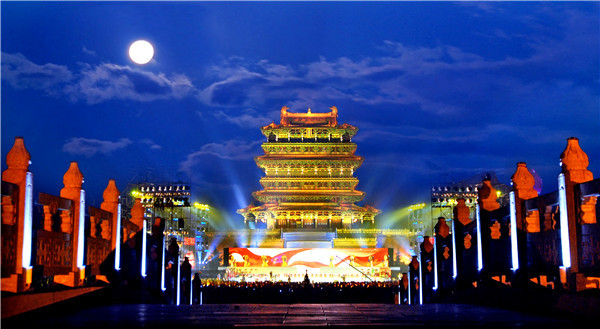
The interior building has six floors, with stairs hovering up in the east and west corner. The overall building structure is just a display of Puzhou culture, or murals, or sculpture. The meticulous idea, the good quality material, the well-made style is like the performance of the cradle of Chinese civilization.
Entering the first floor, visitors will notice that there is a vastly spacious hall with the theme of a poetic masterpiece through the ages.
The first floor mainly introduces the poet Wang Zhihuan of the Tang Dynasty and his poem" On the Stork Tower ", which is the key and value of the Stork Tower. Because this poem represents the prosperity of poetry in the Tang Dynasty, it has become a cultural bearer. This poem facilitates the building world famous. A huge fresco, 18 meters long, hardwood color plastic is on the south wall of the hall to the north, which is the presentation of the great prosperity in the Tang Dynasty. Leaning on the mountains and next to the river, Puzhou City is so magnificent. Temples alternated with pavilions. Wide streets and narrow alleys intertwisted. Heavy traffic and busy people were here and there. Pu Jindu Bridge is crossing over in the west gate and the Pujiu Temple stands out majestically in the east suburbs. Puzhou in the Glorious age of Tang Dynasty is a strategically important town and a cultural key city. The mural on the left is the edge of the Yuwen building, which introduces the origin and historical evolution of the Stork Tower, and the right-hand mural, which is the painting wall of the three poets introducing a famous story of Wang Zhihuan.
The second floor with the theme "Long history"
This floor mainly shows the history of the five thousand years of civilization in the east of the river and the uniquely ancestral culture. The walls around the building are inlaid with 12 frescoes, showing the historical figures and legends of ancient Puzhou as the birthplace of Chinese civilization, the Goodness Mending the Sky, the Yellow Emperor’ pacification, the non-hereditary imperial succession of the King Yao, the capital of the King Shun’s times, the King Yu’s excavation, as well as the historical stories of Puzhou celebrity.
The third floor with the theme "The Ancient Civilization"
This floor mainly shows the history of civilization such as lighting fire, making salt, smelting iron and making wine in the ancient period of the Chinese nation. Puzhou is located in the middle of the Yellow River so ancient humans left an evolutionary footprint, there are the process of civilization evolution and the results of the performance everywhere.
The history of human firemaking is the discovery of the West Houdu site, 600,000 years ahead of schedule. It was also the first developed area for human being to make salt. Yuncheng salt pond, as early as the time of the Yao and Shun Period, has been eating natural salt crystal.
Puzhou region has become the earliest birthplace of human beings, the main reason should be that there is water and salt. During the Spring and Autumn Warring States period, salt ponds have been mined by hand, to the Tang Dynasty, salt production technology has been quite mature, salt production has multiplied. There is a major road in front of the Pujiu Temple in the past, which locals called "salt car trench". It is the vital communication line of the supply for the capital city of Chang'an and export transport.
The smelting iron technology also appeared very early in Puzhou area. In Tang Kaiyuan years, the national iron was up to more than a quarter of the whole annual output for the casting of fixed pontoon bridge iron ox anchor, which shows that the smelting technology has been quite mature. Europe and America will have to wait more than 700 years to reach this level.
Puzhou's wine-making technology is as early as the Northern Wei period. The famous wine "Sangluo wine" is made in Puzhou. "Sangluo wine" with mulberry brewing exquisite technology, plus Puzhou spring water clear, is unique with wine fragrance. Yu Xin, a poet in the North Zhou saw the Governor in Puzhou, he asked for it only. It can be seen that the Sangluo wine is the world's early famous wine. The famous alcoholic drink brand, such as Fen and Maotai appeared later. Yu Xin wrote a poem called “On making me begging wine at Puban” he wrote: “the Sangluo wine at Pucheng with chrysanthemum fragrance.” Another famous poet, Bai Juyi in the Tang Dynasty, also wrote a poem praising "Sangluo wine": "the fragrance of Sangluo wine makes people warm, the sound of mulberry brewing makes people delighted." The poems and allusions after the Tang Dynasty don't have to be mentioned here.
Puzhou has a long history of mulberry and cotton cultivation, textile and folk crafts. It should be emphasized that wine-making and iron smelting in Puzhou. The birthplace of fire in the West Houdu site and the salt-making city are the territory of Puzhou in the Tang Dynasty.
The fourth floor is with the theme “Looking back on the past and looking forward to the future".
The original theme “Peak Prosperity” has been changed into “Looking back on the past and looking forward to the future" today. The existing model of the building takes the historical clues of the building so far as its longitude, the various periods of the great events experienced by the Stork Building as the latitude. With the help of the fusion of high-tech 3D imaging technology, the vivid original appearance with clear logic is displayed in front of the visitors.
The fifth floor with the theme of “Elegant Poetry"
The five-story floor of the Stork Tower is focused on the elegant poetry. Based on the history of Yongji and the Stork Tower, visitors can understand the position of Yongji in the history of poetry, and the relationship between the Stork Tower and poetry in history. Visitors can experience the essence of traditional Chinese culture and learn classical culture, and experience the charm of Yongji as the "poetry capital".
The sixth floor with the theme of “a grander sight”
This is the most suitable place to express the poet's inner voice at that time. Ascending the stairs, step by step, to the top floor, visitors will have the same eye-catching with the poet. They are quite sure the sunset dropping down the mountain, and indeed the Yellow River streaming to the east, and indeed a thousand miles away! Wang Zhihuan, wrote the scenery of Yellow River to the best. The part" The Yellow River seawards flows” is to go down the flow, and the one "Yellow River far away the white clouds" is the counter current up the flow. The poem “Don’t you see the water of the Yellow River from heaven and run to the sea and never return?” (which is taken from Li Bai’s poem: “Bringing in the Wine”). The spirit of Li Bai was also repeated in the poem of “Waves Washing the Sand” by Liu Yuxi, "The long, long winding Yellow River’s paved with sand; sifted by waves and tossed by winds from the far-off land; now it goes up straight to the Starry River Way; to meet the Cowherd and Weaving Maid far away”. The two poems have not completely jumped out of Wang’s artistic intention. Who can surpass Wang's poetry at this level? Although only six poems of Wang Zhihuan have been passed down to the modern era, his poems are the pinnacle of the Tang poetry. It is the most long-lasting and widespread. This poem “On the Stork Tower " can be said to be the best known to women and children, from primary school textbooks to teaching materials selected in China. Even textbooks in Japan and many countries in Southeast Asia make this poem a literary must-read. Hong Kong and Macao have launched a public selection of the 10 best representative of traditional Chinese culture of ancient poetry, but the poem On the Stork Tower is always in the first place among the different results. The Chinese textbook in Japan are selected five poems in the Tang Dynasty, and On the Stork Tower is listed in the first. It is obvious that magnificent scenery of the building of the Stork Tower has not only won the heart of the Chinese people but also the people of other countries. Without cultural implications, the artistic conception transcends the national boundaries. Each word in this poem “The sun along the mountain bows; the Yellow river seawards flows. If you'll enjoy a grander sight, you’d climb up to a greater height.” is the eulogy of the magnificent mountains and rivers of the motherland and every word of the poem On the Stork Tower is a deep philosophical revelation. Standing on the top floor of the Stork Tower next to Wang Zhihuan's bronze statue, you will understand the scene of life and love in the scene. Reading the poem On the Stork Tower, people will sense again and again. The poem On the Stork Tower is a lesson, let people get much enlightenment; The poem On the Stork Tower is a music, let people get deep thought; The poem On the Stork Tower is a painting, let people get plenty beauty to enjoy. Now we have been the top state of vision, we know that it was here that the poet Wang Zhihuan understood the profound philosophy, which inspires us to abandon the shallow and expand a better new realm. May each of us work hard along our ideal goals in life to realize our best wishes. Finally, may the tour of the building bring you unlimited future to a higher level.
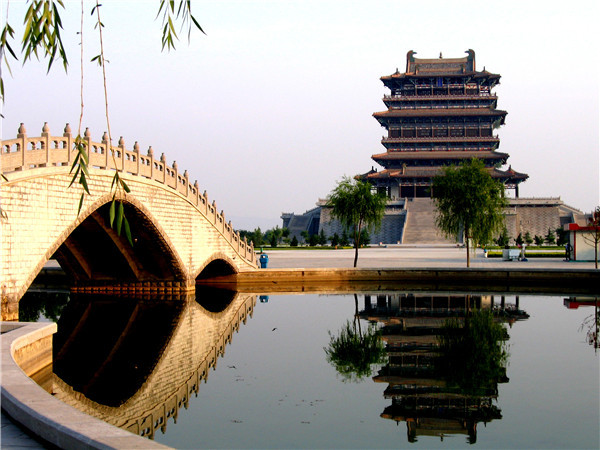
WeChat Official Account: guanquelou
Hotline:
Scenic Area: 0359-8485381 Ticket Center Tel: 0359-8485390
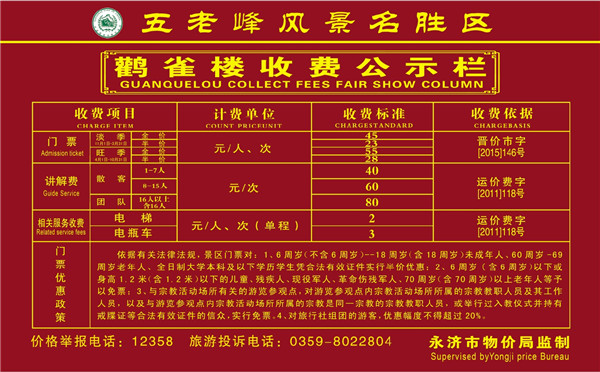
Scenic traffic guide:
Self-driving route:
Xi'an (Xianyang) direction: you can get off (turn to) Fenglingdu Yellow River Bridge (Yunfeng Expressway) at Qindong station of Xi'an (Lianhuo Expressway) and take the Tourist Road West of Yongji to stork tower scenic spot.
Zhengzhou (Luoyang) direction: You can get off at Zhengzhou (Lianhuo Expressway), Qindong station, turn to Fenglingdu Yellow River Bridge (Yunfeng Expressway), Yongji West Tourism Road to stork tower scenic spot.
Taiyuan (Linfen) direction: You can get off at Taiyuan (Universiade Expressway), Linfen (Yuncheng Ring Expressway), Yuncheng (Yunfeng Expressway), take Yongji West Tourism Road to stork tower scenic spot.
Bus route: You can take bus No.2 and No.3 from Yongji bus station and get off at Pujiu Temple scenic area, then transfer to battery car to stork Tower Scenic Area

